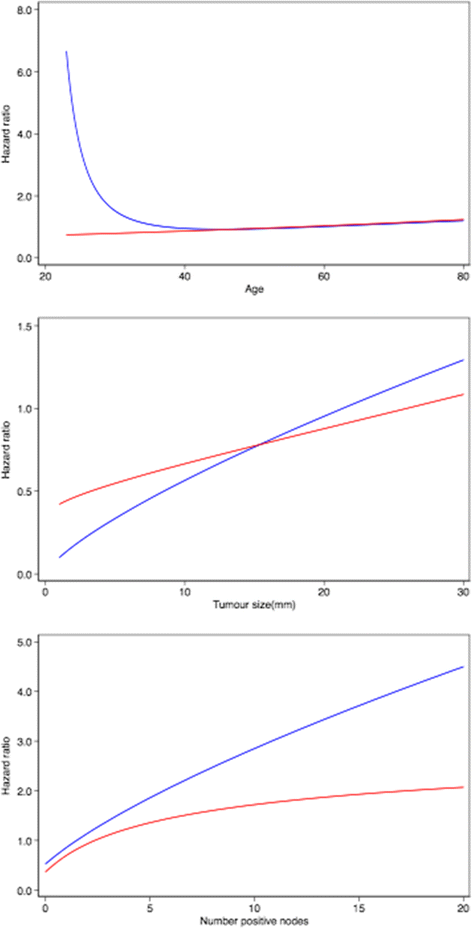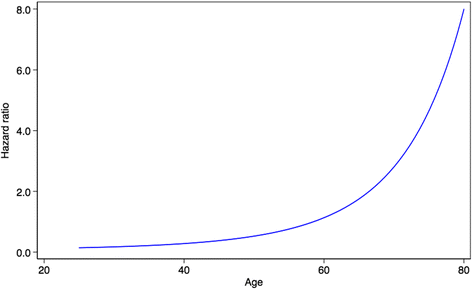An updated PREDICT breast cancer prognostication and treatment benefit prediction model with independent validation
- PMID: 28532503
- PMCID: PMC5440946
- DOI: 10.1186/s13058-017-0852-3
An updated PREDICT breast cancer prognostication and treatment benefit prediction model with independent validation
Abstract
Background: PREDICT is a breast cancer prognostic and treatment benefit model implemented online. The overall fit of the model has been good in multiple independent case series, but PREDICT has been shown to underestimate breast cancer specific mortality in women diagnosed under the age of 40. Another limitation is the use of discrete categories for tumour size and node status resulting in 'step' changes in risk estimates on moving between categories. We have refitted the PREDICT prognostic model using the original cohort of cases from East Anglia with updated survival time in order to take into account age at diagnosis and to smooth out the survival function for tumour size and node status.
Methods: Multivariable Cox regression models were used to fit separate models for ER negative and ER positive disease. Continuous variables were fitted using fractional polynomials and a smoothed baseline hazard was obtained by regressing the baseline cumulative hazard for each patients against time using fractional polynomials. The fit of the prognostic models were then tested in three independent data sets that had also been used to validate the original version of PREDICT.
Results: In the model fitting data, after adjusting for other prognostic variables, there is an increase in risk of breast cancer specific mortality in younger and older patients with ER positive disease, with a substantial increase in risk for women diagnosed before the age of 35. In ER negative disease the risk increases slightly with age. The association between breast cancer specific mortality and both tumour size and number of positive nodes was non-linear with a more marked increase in risk with increasing size and increasing number of nodes in ER positive disease. The overall calibration and discrimination of the new version of PREDICT (v2) was good and comparable to that of the previous version in both model development and validation data sets. However, the calibration of v2 improved over v1 in patients diagnosed under the age of 40.
Conclusions: The PREDICT v2 is an improved prognostication and treatment benefit model compared with v1. The online version should continue to aid clinical decision making in women with early breast cancer.
Keywords: Breast cancer; Prognosis.
Figures




Similar articles
-
Assessing the Performance of the PREDICT Breast Version 3.0 Prognostic Tool in Patients With Breast Cancer in the United States.J Natl Compr Canc Netw. 2025 May 12;23(6):227-233. doi: 10.6004/jnccn.2025.7014. J Natl Compr Canc Netw. 2025. PMID: 40354821
-
Estrogen receptor quantitative measures and breast cancer survival.Breast Cancer Res Treat. 2017 Dec;166(3):855-864. doi: 10.1007/s10549-017-4439-6. Epub 2017 Aug 19. Breast Cancer Res Treat. 2017. PMID: 28825224 Free PMC article.
-
External validation and clinical utility assessment of PREDICT breast cancer prognostic model in young, systemic treatment-naïve women with node-negative breast cancer.Eur J Cancer. 2023 Dec;195:113401. doi: 10.1016/j.ejca.2023.113401. Epub 2023 Oct 30. Eur J Cancer. 2023. PMID: 37925965
-
Tumour profiling tests to guide adjuvant chemotherapy decisions in early breast cancer: a systematic review and economic analysis.Health Technol Assess. 2019 Jun;23(30):1-328. doi: 10.3310/hta23300. Health Technol Assess. 2019. PMID: 31264581 Free PMC article.
-
Prognostic models for breast cancer: a systematic review.BMC Cancer. 2019 Mar 14;19(1):230. doi: 10.1186/s12885-019-5442-6. BMC Cancer. 2019. PMID: 30871490 Free PMC article.
Cited by
-
Personalized Decision Making on Genomic Testing in Early Breast Cancer: Expanding the MINDACT Trial with Decision-Analytic Modeling.Med Decis Making. 2021 Apr;41(3):354-365. doi: 10.1177/0272989X21991173. Epub 2021 Mar 3. Med Decis Making. 2021. PMID: 33655778 Free PMC article. Clinical Trial.
-
An Immune Model to Predict Prognosis of Breast Cancer Patients Receiving Neoadjuvant Chemotherapy Based on Support Vector Machine.Front Oncol. 2021 Apr 27;11:651809. doi: 10.3389/fonc.2021.651809. eCollection 2021. Front Oncol. 2021. PMID: 33987087 Free PMC article.
-
Assessing the Role of Artificial Intelligence (AI) in Clinical Oncology: Utility of Machine Learning in Radiotherapy Target Volume Delineation.Medicines (Basel). 2018 Dec 11;5(4):131. doi: 10.3390/medicines5040131. Medicines (Basel). 2018. PMID: 30544901 Free PMC article. Review.
-
Whole genome sequencing of breast cancer.APMIS. 2019 May;127(5):303-315. doi: 10.1111/apm.12920. Epub 2019 Jan 28. APMIS. 2019. PMID: 30689231 Free PMC article. Review.
-
Winter is over: The use of Artificial Intelligence to individualise radiation therapy for breast cancer.Breast. 2020 Feb;49:194-200. doi: 10.1016/j.breast.2019.11.011. Epub 2019 Nov 26. Breast. 2020. PMID: 31931265 Free PMC article.
References
-
- Kattan MW, Hess KR, Amin MB, Lu Y, Moons KG, Gershenwald JE, et al. American Joint Committee on Cancer acceptance criteria for inclusion of risk models for individualized prognosis in the practice of precision medicine. CA Cancer J Clin. 2016;66(5):370–4. doi: 10.3322/caac.21339. - DOI - PMC - PubMed
-
- Amin MB, Edge S, Greene F, Byrd DR, Brookland RK, Washington MK, et al. In: AJCC cancer staging manual. 8. American Joint Committee on Cancer (AJCC)et al., editors. New York: Springer; 2016.
Publication types
MeSH terms
Substances
Grants and funding
LinkOut - more resources
Full Text Sources
Other Literature Sources
Medical

